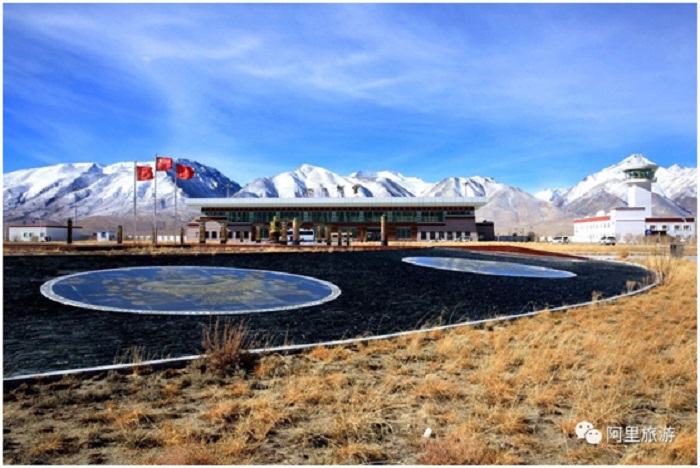



By Zhao Zhanhui, People’s Daily
Ngari, a remote prefecture located in the border area of Southwest China’s Tibet Autonomous Region, is now connected to the rest of the country by the Ngari Gunsa Airport.
Covering an area of 304,000 square kilometers, Ngari is home to over 120,000 permanent residents. It is nicknamed the “top of the roof of the world” for its average altitude of over 4,500 meters.
Shiquanhe township is the seat of the Ngari administrative office, which is over 1,300 kilometers from its nearest city, Hotan in Xinjiang Uygur Autonomous Region to the north, 1,400 kilometers from Tibet’s capital Lhasa, and 5,100 kilometers from Beijing.
Roads were the major way of transportation for the people in Ngari to go to Hotan, and Tibet’s Shigatse and Lhasa before the Ngari Gunsa Airport, southwest to Shiquanhe township, was officially put into operation in 2010, said an executive at the airport, adding that the trip to Lhasa would always take at least 40 hours.
The Ngari Gunsa Airport, which started construction in May 2007, is the first civil airport ever built in northwest Tibet.
By overcoming difficulties such as harsh weather conditions, short construction period, and long-distance transportation of building materials, engineers and technicians completed the construction in just three-odd years and built an “air bridge” between Ngari and Lhasa, as well as the rest of China.
On July 1, 2010, an A319 aircraft landing on the new airport marked the official operation of the civil aviation facility, making it the fourth one in Tibet under operation.
So far, it has opened four routes linking the cities of Lhasa, Kashgar, Urumqi and Xi’an. A total of 7,169 takeoffs and landings have been completed in the airport in the past 10 years, carrying 491,367 passengers and 365 tons of cargos.
Ngari Gunsa Airport, situated at 4,274 meters above sea level, is the fourth highest airport in the world. With a terminal building covering about 4,000 square meters, the airport can operate a maximum of 4 flights and 300 passengers per hour at peak time, and its annual throughput capacity was planned at 120,000 passengers.
Due to the thin air, high altitude and other climate conditions, the airport faces troubles in water, power and heating supply, “altitude sickness” of equipment and facilities, high pressure on safe operation, and lack of daily necessities.
However, it has ensured overall safe operation in the past 10 years and accumulated experiences that could set a reference for other plateau airports.
The airport has initiated barbed wire fences to eliminate potential dangers, tailored insulation layers for water heating pipes to protect them from freezing and cracking in winter and solved through trials equipment failures caused by extreme climate conditions on the plateau area.
The airport shortens the travel time between Ngari and Lhasa from over 40 hours to two hours, and allows residents in the prefecture to arrive in China’s major cities within one day. The fast and convenient air flights have greatly improved the travel experience of residents in Ngari and granted visitors easier access to the prefecture.
The airport has significantly improved the transport links in the previously isolated prefecture, ignited the dynamism of the society and brought significant changes to the prefecture’s economic and social development thanks to smoother travel and logistics channels, the executive of the airport said.
Civil aviation has served as a powerful driver for the economic development of Ngari, laying solid foundations for investment attraction and bringing the prefecture’s high-quality tourism resources to more visitors.
According to data released by the Ngari administrative office, the prefecture received over one million visitors in 2019 from 61,300 in 2010, growing an average of 38 percent every year. With an average annual increase of 42 percent, Ngari reaped over 1.37 billion yuan ($194 million) of tourism revenue in 2019 from 60 million yuan in 2010. Besides, the prefecture’s GDP increased by an average of 14 percent annually to over 6.2 billion yuan in 2019 from 1.85 billion yuan in 2010.
The airport has also improved the livelihood of the local people. At present, it is no longer difficult for local residents to by stuffs from outside the region such as fresh vegetables, fruits and seafood. It is also more convenient for them to seek jobs, pursue education and seek medical treatment.


Cooperation between China and Nigeria had.



Nigerian government has urged trainees of.



Minister of State for Foreign Affairs,.


The Nigerian Government has congratulated the.


The Humanitarian Service Diamond Awards has.
A Chinese Company, Inner Galaxy Steel.


The Programme Coordinator, Regulatory, Compliance and.


A Non-Governmental Organization (NGO), Committee for.
The Trustfund Pensions Limited has chided.


The House of Representatives Committee on.
Leave a Comment